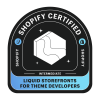Do you wonder what is actually going on inside a software development company while they are working to create your shop? Are you interested to learn how to build an online store from scratch and how to choose the right development team?
We will cover all the phases needed that are taking place in creating your software project. After reading this blog, you will be able to understand and follow what your development partner is doing. This knowledge will also allow you to choose a better partner for you. Also, it will give you the opportunity to dismiss proposals from companies that can’t provide the level of quality or simply overprice.
Software projects base principles #
Building a webshop is in many ways similar to building any other web application. The process of building software has matured over the years. There are different approaches and methodologies to building high-quality software projects. In this document, we’ll guide you through the proposed steps to make your project successful with minimal resources. Modern digital product development is based on two core principles:
- Higher investment in planning and preparation throughout the whole project
- MVP (Minimal Viable Product) approach.
Let’s explain how you can invest in planning, preparation, and testing the right way.
There are 5 stages you go through until you finish your project. And each of the phases leans on the previous one. That is why skipping steps can lead to much time wasted later.
So planning and testing assumptions in every phase will avoid costly development mistakes. As phases of the project progress, so do the complexity, length, and price increase. This is why the first steps are the most crucial.
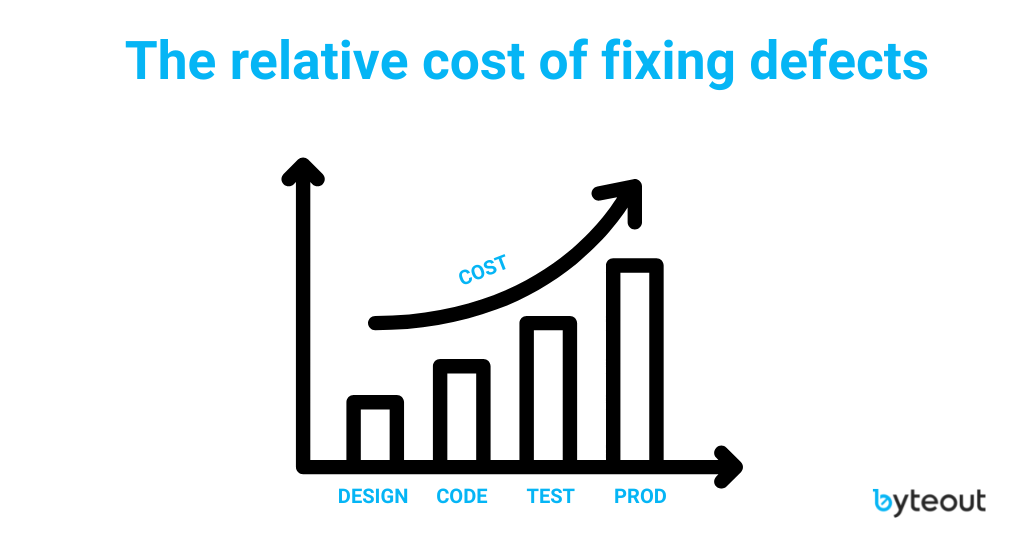
The second principle, Minimal Viable Product approach, is a mindset that started with research by scholars such as Frank Robinson and Steve Blank. It was best described for the first time in the book The Lean Startup by Eric Ries.
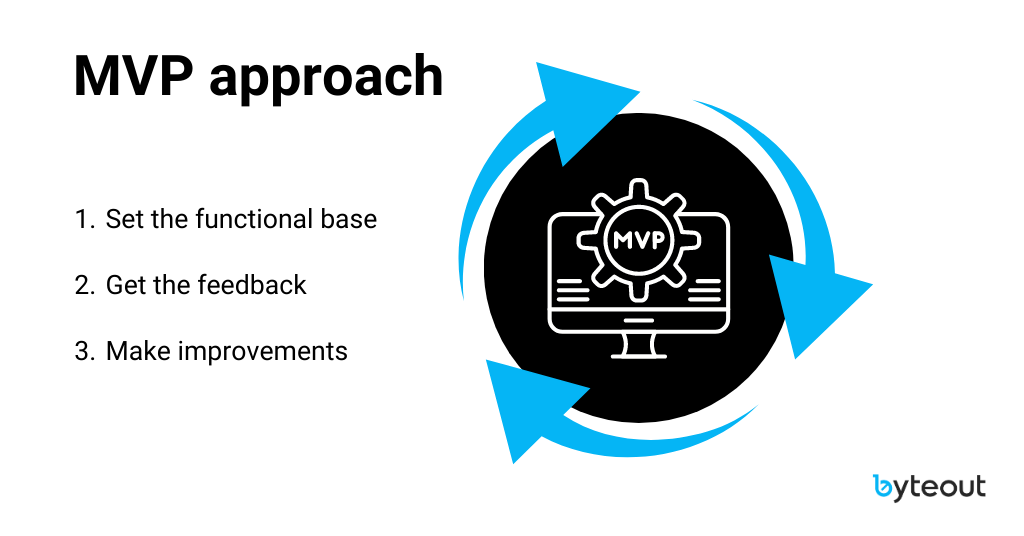
The MVP approach is simple: start with building the most important thing with basic functionality. It is crucial to get to a functional system as fast as possible to decrease the risk of failing. Then, you make improvements based on customer feedback and iterate them step by step.
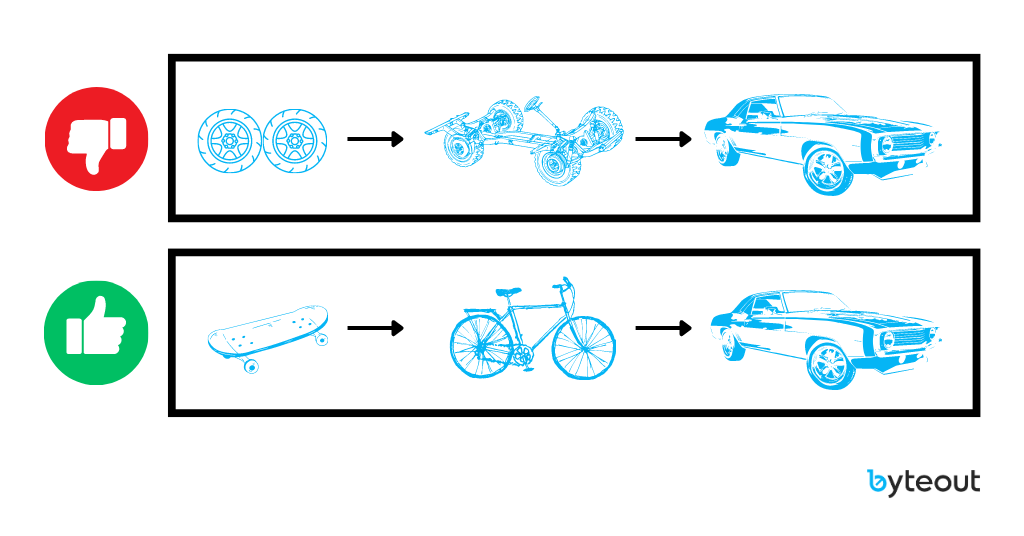
5 steps to build software projects #
The steps we will expose in this blog can be seen as best practices in almost all cases, and the rest are details.
Step 0 – Discovery session #
One of the first things you should do is start by signing the NDA. In the majority of cases, you actually won’t need it, but just do it, so you are completely open with your business goals. The more your development partner knows, the more you will get back. Most of the time, you will be surprised by the amount of useful advice, even in the business domain.
Why is a good discovery session important?
The discovery session is more like a consultation. You will go through your ideas, needs, and expectations of the project. But you will also cover mutual expectations in terms of collaboration.
The discovery session is in the form of a meeting, and it usually lasts about 30 to 60 minutes. Also, it should be free of charge.
PRO tip: Share all the materials about the project you might have before the meeting. That way, your development partner can better prepare for the meeting.
Step 1 – Brand definition #
Why is defining your brand so important? Especially if we are talking about “just” building your shop.
Let us help: think about who will use your product and how you want consumers to perceive you. This process starts with the first interaction with customers. The whole lifecycle includes them being your customers and having them recommend you. You have an option of not caring about all of this, but you also have an option of architecting this experience. That’s called a brand.
Building a brand is a long process. It starts with defining it and communicating within the organization and with all the people you collaborate with. That especially includes the people who physically build your product.
The first step for anybody who doesn’t have a developed brand is to work on it in an effective, tried, and tested way. Using a system and workshops will quickly give you clarity on your brand and how it reflects the values and mission of your product.
To find out where your brand stands and gain control over its identity, you need to answer a few key questions:
- What do you see as your mission and vision?
- What are your values?
- Who is your target audience?
- What are your competitive advantages?
The output of the workshop gives you and your team a common language to understand the brand. It will make future decisions much more comfortable. Those decisions are about visual identity, tone of communication, positioning, marketing, and others. When we do these workshops with potential clients, it’s not helpful only for them. It also helps the whole team to be more informed.
Step 2 – Product Workshops #
After completing the previous step, you now have your brand defined. You know your goal, the audience you serve, and the advantages you have over competitors. With that, you are ready to start thinking in more down-to-earth terms. It’s time to decide what features and functionalities your product must have in order to provide value to your customers.
Industry standards and best practices show that several methodologies can help you be efficient in defining and prioritizing development roadmap. Most of it is based on Design Thinking and split into several workshops.
These workshops are tailored to the project’s needs. They are there to help you manage your product strategy and create clear roadmaps. All questions about business objectives, user experience, and technical aspects are covered. The participants are key stakeholders from your side and key product team members. Depending on the project’s complexity, you can have one or several sessions.
With all of this, you aim to align the team, set a clear direction, and have a defined minimum viable product (MVP) and development strategy.
These are some of the exercises you might encounter in the product workshop sessions:
- Problem statements – analyze the idea from the user’s perspective, trying to understand their goals and needs.
- User story mapping – define steps users need to go through to achieve their goal.
- Prioritization – define essential features for the MVP version of the project.
- Quick sketching – create basic sketches of the most important user journeys to identify potential problems in the flow early.
The most important output you get from this stage is the most important functionality, which needs to be developed first. It should be clearly defined and estimated in terms of the effort to make it and the value it brings to the product.
Step 3 – Wireframing #
Wireframes are basically sketches of all the screens. Other than the elements they contain, there are interaction flows between them.
By drawing the wireframes, we define the User Experience (UX) of the whole project. This is the first time you actually have a rough visual representation of your product. This brings a new layer of understanding to the whole team.
Depending on the level of certainty, the wireframe can also be clickable to mimic the real feel of the product before even building it. Doing this step correctly saves a lot of time in development implementation at a later stage. It removes most of the misunderstandings the development team might have about how exactly something should look and function.
Best practices in user experience guide you to use the wireframes (clickable mockups). That way, you have the opportunity to test them with a handful of volunteer users from your target audience. The aim is to learn as much as you can about how the users interact with your product. For things that are not optimal, you can change or improve the interfaces and flows. This step is often overlooked, but in essence, it can save you months of development time down the line.
Step 4 – Design #
Humankind has been expressing itself visually long before we invented reading and writing. It is deep in our nature to be drawn to things of beauty and only then focus on the functional side of objects. Instead of fighting this human bias, great products embrace it. They invest a considerable amount of time in creating visually appealing and inclusive design systems.
This phase of building your product relies heavily on what your brand represents. It needs to align with it perfectly, as well as to enhance further the user experience design which was drawn up in the previous phase. Design of the product is both a science and an art. Also, you need to think about things such as color psychology, shapes, spacing, typography, user expectations and habits, what to expose the most, and many other things.
Investing in a great product also means investing in the design details because you will be exposed to competitive markets. Customer expectations are constantly increasing. The visual design maximizes responsiveness, efficiency, and overall success of a website.
Step 5 – Development #
The development stage is the central and the most expensive part of creating products. The quality of its output depends on all the steps beforehand. So make sure you don’t skip them.
How to choose the team #
There is no single way you can choose your development partner. Advice and things to consider when doing so include the following:
- Ask people you trust for recommendations.
- Have several meetings with the team or even have a small test project with them. This is like dating, choose the partner you can develop a good relationship with.
- Ensure the team has relevant experience and is on the market for some time.
- If choosing a single contractor instead of a team, ensure sure you have a backup.
If you are still unsure about what to do, hire an external consultant to help you with the decision.
How you organize your project #
You will usually face a choice of organizing the delivery in two ways, agile and waterfall.
The waterfall method is older and is used less and less today. But it is easier to understand.
In this method, you define the whole project and write down the requirements in detail. Developers estimate the time needed to make the projects you specified. After their estimations, you get a fixed price quote for it. The project is delivered to you when it’s completed.
The downside is the lack of flexibility. You have to know and research everything in advance, which is usually a lot of guessing. And it is especially difficult for larger projects. Of course, you can add or change features, but it introduces more complexity. And they are all estimated and priced additionally. A common name for them is Change Requests.
The agile method uses a flexible approach to working in small chunks. You get results delivered every few weeks, and you are able to test and use the functionality. This way, you always choose to work on the most important features first.
Getting feedback and iterating early is the key value this approach brings. This removes both the product and market risk. It gives less predictability of the whole budget upfront. But it gives more flexibility to manage the project according to the budget. You can cut less important features during the project or add new features if the budget permits.
Technology consideration #
Technology choice can be confusing when developing your e-commerce project. In most cases, your development team will suggest the right option. And if you are not very technically skilled, you should let them do it.
But it’s important to stay informed, understand their reasoning, and try to compare the options given. Sometimes that insight is valuable for the development team to make a decision. Teams are usually experts in one technology, and that can be one of the key factors for the choice of technology.
One more option you have to choose is between open-source and closed-source tools.
Open source is a model where code is public and available for reuse. This means you can inspect your tooling and adapt it to your use case. The software is free, but you might pay for support or further development. And you are free to contribute back to the project and community. But, if you plan to change/adapt your code and then sell it, this model doesn’t allow it. Although you can sell access to the (SaaS) service, you make it with the code, which a lot of projects do. Some examples of open-source projects are Linux, WordPress, and Firefox.
In the closed-source model, you don’t see the source code but only use the tools. Companies develop and maintain these tools and usually make money by selling/leasing. The most famous examples include Microsoft, Shopify, and Salesforce. If you work in a corporation, you might have policies or contracts which force you to use a specific vendor.
When developing your project, some parts of the project might exist, and you can buy/lease them. Sometimes, you can find a ready-made solution for your basic needs. Choosing whether to build VS buy software parts is an important and complex topic. There is no universal answer, and the choice includes both technical and business aspects.
Some extra considerations in how to choose the tech:
- Is it the same or compatible technology you already use?
- Is it easy for you to find more experts familiar with the technology?
- Licensing agreements and associated costs
- Are you locked in and dependent on one vendor?
- Is the technology proven and stable?
Delivery #
Make sure you agree on the way you release the software to customers. Some simpler projects might be OK with releasing the changes once all changes are ready. But large projects usually have a system in place, such as Continuous Delivery.
Continuous delivery is one of the dominant ways modern software is released. It includes constantly releasing features to customers, even several times per day. This is very fast and efficient, but it requires you to have a reliable system. You need automated tests, procedures for reverting changes on errors, and people who check everything.
Quality Assurance #
Releasing your product to the public is a stressful moment. Customers have high standards, and you want your product to be flawless. For these purposes, teams have dedicated Quality Assurance experts. They are in charge of testing your application and making sure of the quality standards.
Sometimes due to budget restrictions, projects omit testing and QA. But it is not a wise decision in the long term.
Another thing to consider is the security of your project. Especially in e-commerce projects, where you hold customer and payment data. So make sure you follow all the security best practices. If the budget allows, hire an independent security expert to test the system further.
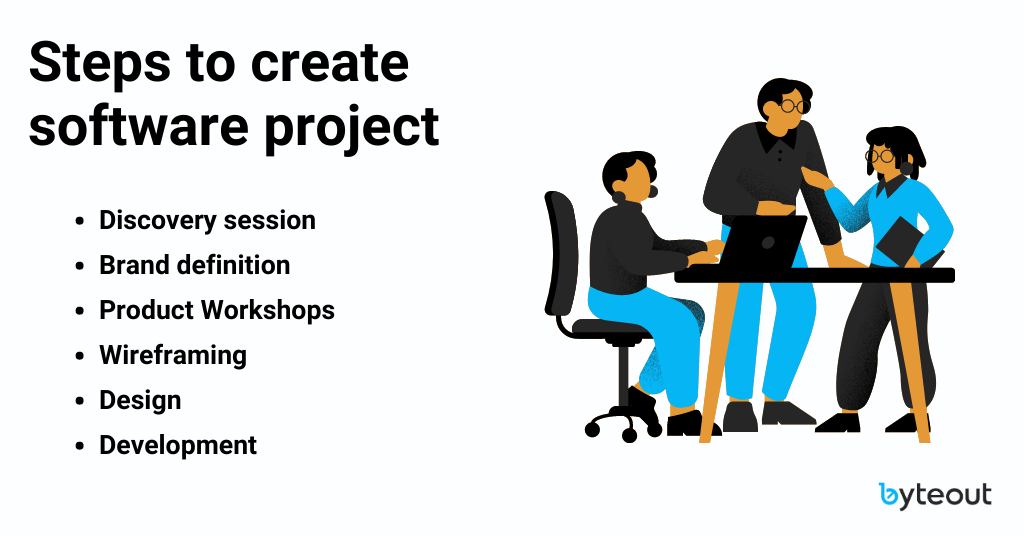
Releasing the product #
Releasing the project live feels like a win, and it should. Before the official release, ensure that everything runs as smoothly as possible. That means that the project has passed serious testing procedures. If your project delivers a bad user experience at any stage, the users will not use it and won’t think twice about it. You’re probably too late if you plan to start testing a few days before the official launch. The earlier you test, the earlier you’ll notice the flaws. And, if you fix them early enough, you will gain users’ trust.
In the beginning, the development team usually creates a standard testing procedure that should be followed along the way. Every newly developed feature can be tested in the early stages. One of the options for the pre-launch testing is to make an invite-only beta launch. Feedback from a trusted network may help you solve bugs or UX/UI issues.
Choosing the right infrastructure is important for the stability of your webshop. Make sure you stress test your product and plan resources in advance based on your expected load. This includes choosing the right cloud provider, choosing the storage capacity, number and type of CPUs, memory capacity, setting the right caching strategies, introducing CDNs and DDoS prevention services such as CloudFlaire and much more.
Good practice also includes monitoring the state of your webshop closely in the first days of publishing it and incident response procedures in week one after you launch.
And just to have a reality check, no webshop receives tons of traffic just because somebody created it. It takes a lot of energy, knowledge, money, and patience to reach the traffic and sales you want. But if you’ve done your homework and prepared everything, your webshop will not let your customers down when they come.
Difference between web shops and custom web projects #
If you want to create your own webshop, there are more than a few pre-made solutions on the market. They will ease up the whole process of making your online store. You just need to choose the components (also called modules or plugins) you want to have on your webshop, and you are ready to hit the market in no time. You can also customize them in certain ways. The level of customization depends on the component maker.
But as easy as this looks, it does require some time to implement, and you need to know what are the good choices for you. You will also need to invest time to change the basic design so it matches your desired style and branding. Some of the systems offer a variety of pre-made themes which you can purchase and then customize.
For more advanced use cases, you might need to create a custom solution for your project. This happens quite often, but it is more common for other types of projects and not e-commerce. There are no component solutions you can just put together with no additional work. And why is that, you may ask? Well, let’s just say there are over 5 million WooCommerce shops online alone. How many similar custom webshops do you see? Probably not nearly as close to that number.
In those cases, everything will have to be developed from scratch or by using frameworks and libraries to speed up the project. So, it will take much more time and thus be much more expensive. But you do get the product you specifically wanted. This is completely fine, and how a lot of things are made. This includes both the pre-made solutions and platforms mentioned above. Also, this gives you an explanation of how roughly 30 million developers worldwide earn their salaries.
There are other tools and approaches, such as no-code solutions, which we won’t cover now. But it’s always good to research options and possibilities. We might as well see AI covering some of the tedious work developers do today. A great example of this is ChatGPT which completely disturbed the broader digital community in 2023.
How are web projects priced #
There are two main ways to price software projects, Time and Material and Fixed Bid.
With Time and Material, transparency is the key. Every hour is logged, so you always know what exactly you are paying for. Since this method works well with agile, you, as a client, are involved in planning. Usually, you get frequent evaluations, for example, every two weeks. The downside is that you cannot have a precisely planned budget for the entire project since things are flexible. However, you can estimate in advance and re-estimate after periods of time, so you get more predictability. Another important aspect is you can actually put in new features, change and simplify existing ones or completely remove them as you go. This gives much more flexibility on what you want to do with your budget.
Fixed Bid projects are agreed upon in advance, and the price is also set in advance. This gives the predictability some companies want to have and reduces the risk of breaking the estimated budget for them. But, there is no flexibility in changing anything which is already agreed upon unless that is accounted for and additionally paid. The price quoted by the subcontractors is usually padded or increased, so the risk of going above the estimate still goes at your expense. Projects priced this way go along well with the waterfall method of managing projects.
Conclusion #
You saw a modern process of creating webshops and demystified all the steps. Now you can use this knowledge to prepare better and supervise each of the milestones. Think about your budget and how much you can invest in each of the steps. And communicate that with your partner. But do not skip steps, it ends up costing more.
We also covered the two basic principles. Planning each of the steps and having an MVP mindset. Use them as much as you can and trust the process.
With more than 150 projects, we accumulated enough experience to perfect the process. And knowing how to manage the process is important. You will have to balance, cut out the “fat” and make firm decisions to optimize the whole project.
We are here to help guide your project when needed. Grab a free 30-minute consultation before you start your project.
